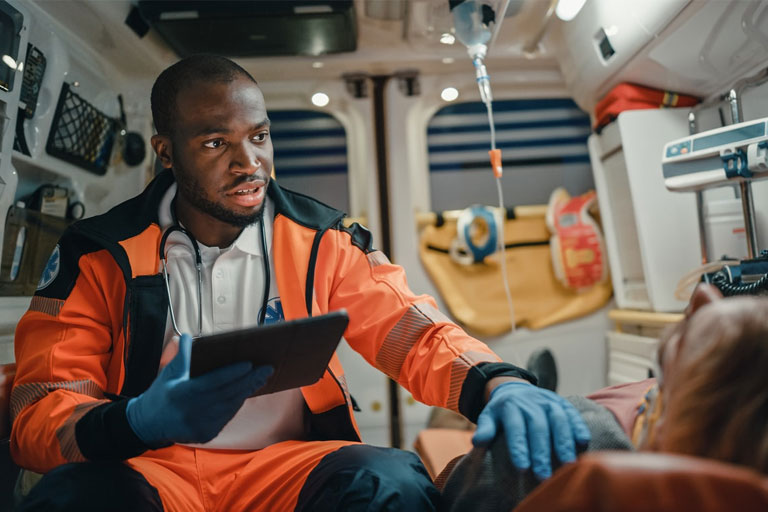When a serious crash occurs on US roads, whether due to distracted driving or something else, emergency medical technicians (EMTs) are usually the first medical professionals to arrive on scene. Working quickly and efficiently, EMTs assess the situation, triage patients, provide emergency care and transportation, collaborate with other first responders, and document the incident. Their rapid response and array of capabilities are critical to maximizing positive patient outcomes.
1. Assessing the Scene
The first responsibility facing EMTs when they reach a crash scene is conducting a quick size-up to assess potential dangers and identify the number and severity of injuries. Checking for downed power lines, leaking fuel, unstable vehicles, and other hazards lets EMTs approach safely and alert other incoming emergency crews of risks. Determining the mechanism of injury also allows EMTs to watch for specific associated injuries during patient assessments.
2. Triaging Patients
EMTs must rapidly perform triage when facing multiple injured patients, quickly evaluating vital signs and visible injuries to determine transport priorities. By labeling patients as immediate, delayed, minor, or deceased, EMTs designate the order in which patients should receive transport and trauma center care based on severity, optimizing patient outcomes.
3. Providing Emergency Care
After assessing scenes and patients, EMTs shift focus to emergency medical care, striving to stabilize patients and mitigate further injuries before transportation. They may control bleeding with dressings, tourniquets, or hemostatic agents, support airways and breathing with suction, oxygen, or ventilations, prevent spinal cord injury by immobilizing patients’ heads and necks, reduce shock with blankets and splints, or administer glucose, epinephrine, or other medications as needed.
4. Transporting Patients
Timely transportation by ambulance to advanced definitive care at trauma centers plays a major role in saving lives after crashes. EMTs continue providing medical interventions en route while navigating safely using lights and sirens per state laws. Choosing appropriate destinations that match patient needs optimizes outcomes.
5. Collaborating with Other First Responders
Though EMTs take the lead regarding emergency medical care, successfully responding to serious crashes also requires effective collaboration with fire, rescue, and law enforcement personnel. Shared priorities like scene safety, extrication of trapped victims, accountable collection of belongings and evidence, fluid traffic control, and clear communications all contribute to orderly, efficient, well-documented responses that give patients the greatest chances of survival with the highest quality of life.
6. Attend Court if Necessary
Unfortunately, serious motor vehicle crashes sometimes lead to criminal charges or civil lawsuits, requiring EMTs to testify about the medical care they provided. EMTs have a responsibility to thoroughly document all assessments and interventions at scenes to recreate an accurate picture later if needed. Clear run reports and notes are critical so EMTs can confidently attest to their actions without hesitation when scrutinized in legal settings months or years later. Testimonies from EMTs provides crucial eyewitness context regarding patients’ presenting conditions, care administered, conversations overheard, crash site details, and more that informs investigations, supports charges, and leads toward equitable civil judgments.
In the aftermath of any significant highway collision, properly trained and strategically located EMTs are in the best positions to rapidly assess unfolding situations, determine patient care needs, provide key emergency interventions, and swiftly transport patients to appropriate hospitals. By fulfilling these vital, multifaceted roles, EMTs strive to manage devastating events and extend care the public depends on when fate turns roadways dangerous.
If you’ve been injured in a car accident and want to know if you can claim compensation with the help of an EMT, contact our team of specialists at Marc Albert. Below, we have listed the three offices you can find us at:
- Astoria – 32-72 Steinway St, Astoria, NY 11103
- Brooklyn – 7113 5th Avenue, Brooklyn, NY 11209
- Syosset – 175 Jericho Turnpike, Syosset, NY 11791
You can also contact us by phone for a free consultation on (347) 472-5080.

